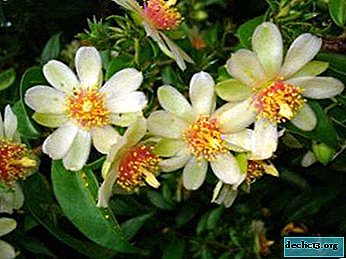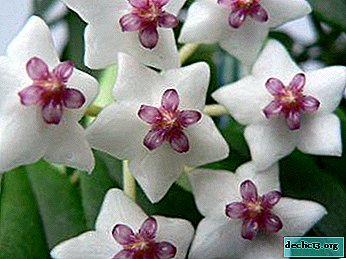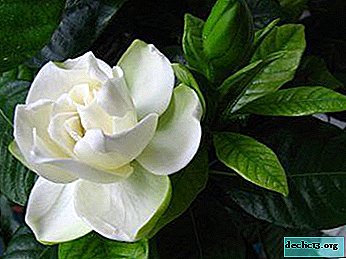What is the unique view of the prickly perennial creeper from the Cactus family? The subtleties of home care

Recently, cacti are gaining more and more popularity among plant lovers. Unpretentious, well-known succulents, whose leaves are replaced by thorns.
Pereskia is the origin of cactus plants, which are common in Central and South America. In the past, cacti consisted of leaves, and when the climate in the deserts was too dry, they began to turn into thorns. And the central part of the plant is able to fulfill all the functions of the leaves.
Description of cactus Pereskia aculeata
Prickly Pereskia (Pereskia aculeata) is a species of fast-growing lianas of the genus Pereskia of the Cactus family. Also known under the names Peresius spiny and Barbados gooseberries. Bushy and climbing plant, it can reach a length of 10 m. It has a fleshy, strongly branching stem, reaching a diameter of up to 1.5 cm. The leaves are oval in shape, dark green, up to 9 cm long and about 4 cm wide. Over time, the leaves fall away, dark areoles with 1 remain in their place -3 hard spikes.
The birthplace of the species are the Antilles, Panama and the northern coast of South America. But it is grown in many countries: tropical America, Australia, Israel, India, California, the Philippines and Hawaii. The fruits of the plant are eaten, and the leaves are used to make salads. Also prickly prickly is used to design hedges.
For the first time, the family of Pereskia was described in 1703 by Charles Plumier. The name of the family was given in honor of the French scientist Nicolas-Claude de Peiresca. Carl Linnaeus attributed these plants to the genus Cactus, and in 1754 Philip Miller placed them in the genus Peresius.
Photo
Check out the photos of this amazing plant:




Home Care
- Temperature. Pereskia shark is a thermophilic plant and will grow well at a temperature of 23-25 ° C. At night, the temperature can be several degrees lower. In summer, it is useful for the plant to be outdoors, but it will be necessary to provide protection from rainfall.
Important: it is worth ventilating the room in which the pereskia is located.
- Watering. During the period of intensive growth, the plant needs abundant watering. Before each new moistening, the topsoil should dry. Excessive moisture can cause rot on the cactus stem.
- Shine. This succulent can grow under any kind of lighting, but to achieve maximum decorativeness it is worth putting the plant on the southern windowsill. Direct sunlight is not dangerous for pereskii, but in especially hot hours it is worth creating a shade for the cactus.
With the onset of spring, the plant should be gradually accustomed to bright lighting.
- Priming. For prickly prickling, a rather heavy and nutritious land mixture is needed, but at the same time it must pass water. The composition of the earth may include clay soil, coarse sand and a small amount of humus.
- Pruning. The plant needs formative pruning. It is usually carried out in the spring, once a year. The resulting cuttings can be used for propagation.
- Top dressing. During the period of active growth (from April to September), succulent must be fed twice a month with fertilizers for cacti. You need to take half the dose of that indicated on the package. Organic fertilizers should be avoided, since an excess of nitrogen is harmful to the roots of pereskia.
 Pot. The plant has a powerful and actively developing root system, so it needs a large pot.
Pot. The plant has a powerful and actively developing root system, so it needs a large pot.
Ensure that there is sufficient drainage in the container.- Transfer. Prickly Peresia is growing rapidly, so young plants need to be replanted every year, in spring or summer, by transferring an earthen coma. After transplanting, the plant should be tied to a support, put in a place protected from the sun and a damp place and not watered for several days. Adult plants are transplanted as needed.
- Wintering. The rest period of the cactus lasts from October to February. The temperature of the room in which the cross is located should be from 12 to 16 degrees. Watering is rare, top dressing is not carried out.
Attention: the temperature should not fall below 10 ° C, this can be harmful to succulents.
Breeding methods
- Cuttings. For propagation, unresolved matured cuttings are used. They are planted in spring or early summer.
- Cuttings are cut with a blade, each handle should have at least 1-2 knots.
- Immediately after this procedure, the cuttings are rooted in a moist mixture of peat and perlite and covered with a film.
At a temperature of 25-28 ° C, seedlings will quickly root and grow stronger, then after 2-3 weeks the seedlings can be transplanted into separate pots. Transplant seedlings should be very carefully so as not to damage fragile roots.
- The seeds. Sowing seeds should be done in early spring. Seeds should be buried in the soil to a depth of 0.5-1 cm, moisten and cover with a film. The temperature should be around 20-22 ° C. The first sprouts will appear in 2-3 weeks, the shelter can be removed. Seedlings are transplanted into separate containers when 4 true leaves appear on them.
Bloom
 Pereskia prickly blooms in late summer - early fall. On young shoots appear cup-shaped, yellowish-white in color with a pink tint, flowers with a diameter of 2.5-4.5 cm. The flowers have a light aroma. After flowering, small edible yellow fruits remain. Only adult plants bloom.
Pereskia prickly blooms in late summer - early fall. On young shoots appear cup-shaped, yellowish-white in color with a pink tint, flowers with a diameter of 2.5-4.5 cm. The flowers have a light aroma. After flowering, small edible yellow fruits remain. Only adult plants bloom.
If the prickly cross does not bloom, it may be in poor conditions. She lacks lighting, fertilizing or moisture. Or she did not reach the right age.
Diseases and Pests
Pests such as scale insects, spider mites and mealybugs can be a threat to plants. When the first signs of infection appear, rinse the succulent with a warm showerwhile ensuring protection of the soil from water.
Also, a cactus can get sick if it is not properly looked after.
Similar plants
- Pereskia orange (Pereskia bleo) - a cactus from the genus Pereskia, reaches a height of up to 5 m, has beautiful bright orange flowers.
- Pereskia moreiflorous (Pereskia grandiflora) - a cactus from the genus Pereskia, can also reach a height of up to 5 m. It blooms in pink flowers.
- Pereskia Weber (Pereskia Weberiana) - a cactus from the genus Pereskia, forms compact bushes. It blooms profusely with snow-white flowers.
- Epiphyllum - a genus of leaf cacti, numbering about 20 species.
- Hatiora (Hatiora) - a genus of leaf cacti from the rainforests of Brazil.
Find out about another type of pereskia, namely Godseff, here.
Prickly prickly - an amazing leaf cactus that can grow both in the room and outdoors. If you take good care of her, you can see a beautiful ornamental plant with beautiful leaves and flowers pleasing to the eye.

 Pot. The plant has a powerful and actively developing root system, so it needs a large pot.
Pot. The plant has a powerful and actively developing root system, so it needs a large pot.















